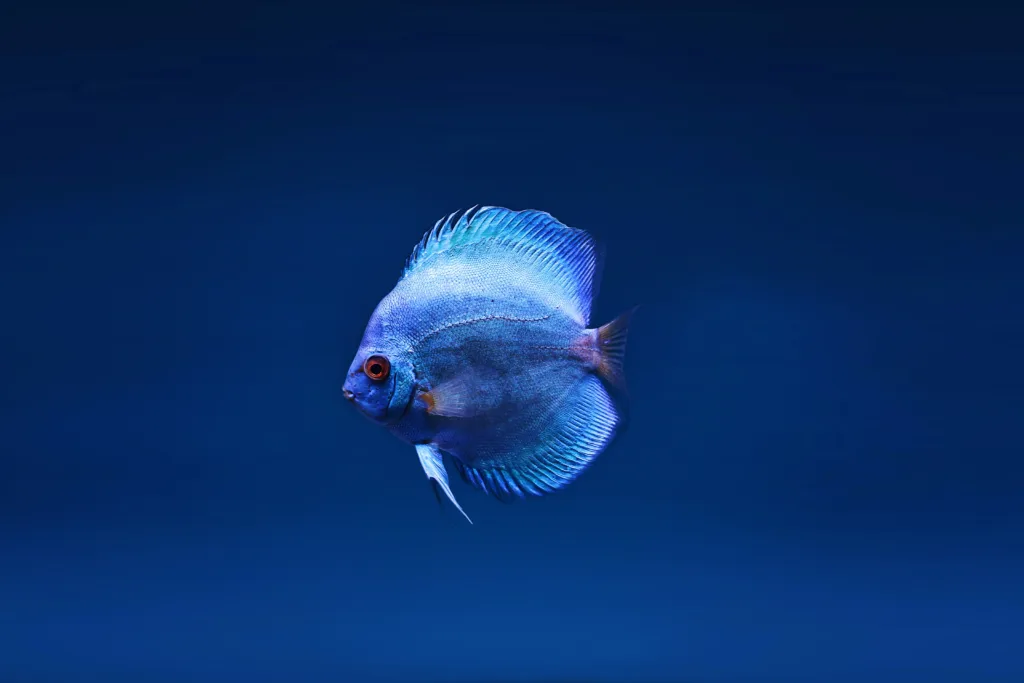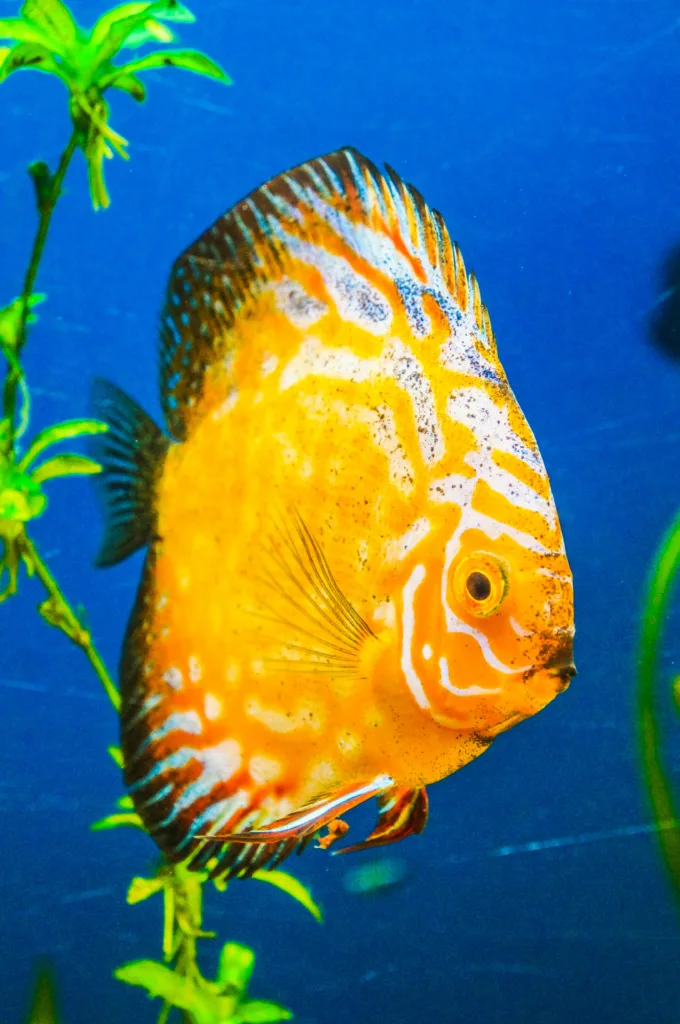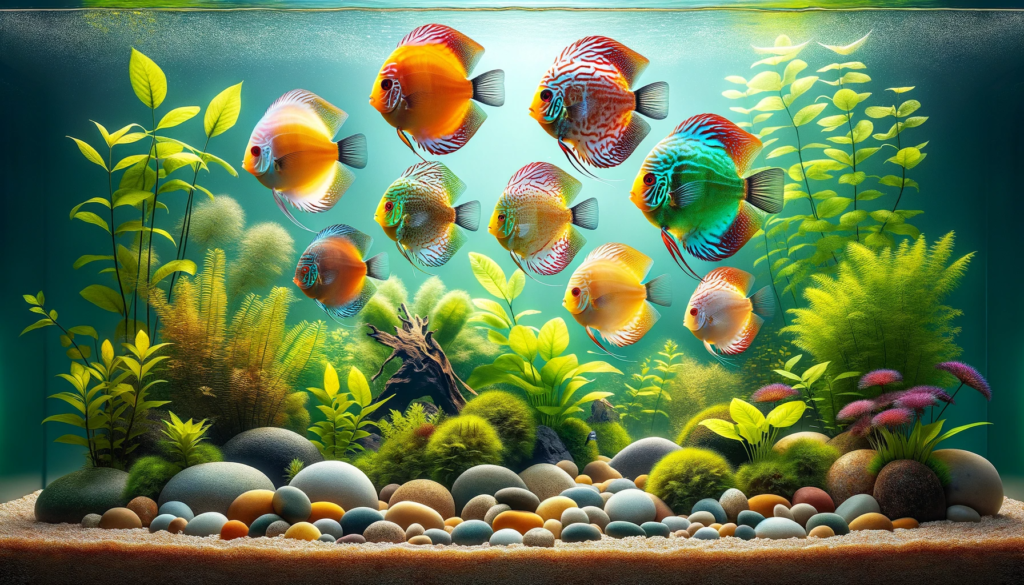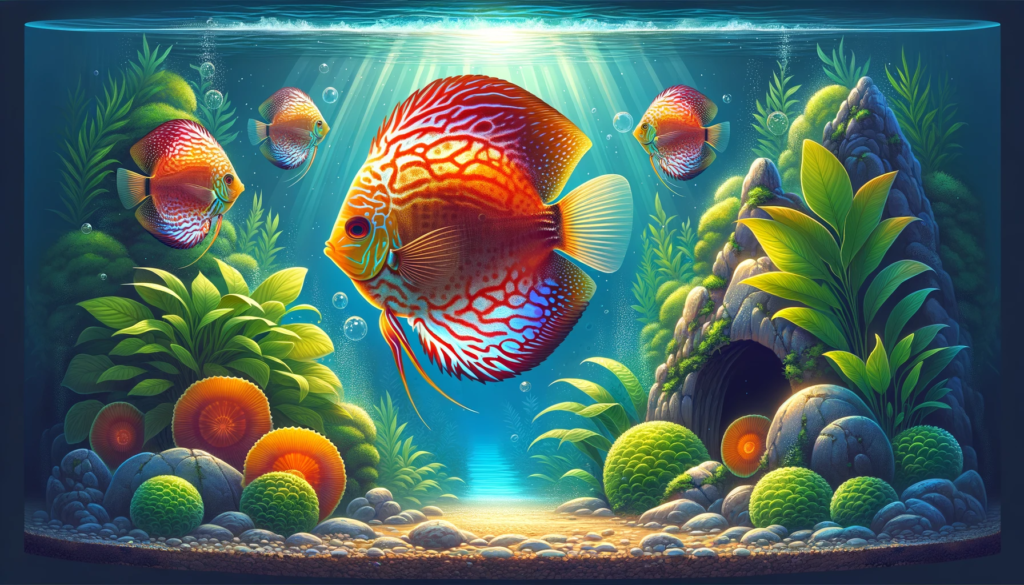You’re about to dive into the mesmerizing world of discus fish care. As ‘King of the Aquarium,’ these creatures captivate with their majesty.
You’ll learn about their Amazonian habitat, water needs, and social behavior.
We’ll also uncover the secrets of successful breeding.
So, are you ready for a fascinating journey? Let’s dive in!
Understanding Discus Fish Characteristics
You’re about to discover the fascinating world of Discus fish.
From the different varieties to understanding their lifespan, we’ll explore these unique characteristics together.
Let’s start our journey towards understanding these majestic creatures better.
What is discus fish
Now, let’s explore the distinct characteristics of discus fish, a captivating species known for its vibrant colors and majestic beauty.
As part of your discus fish care guide, you’ll learn that discus fish types vary in color and size. This species requires diligent discus fish maintenance and discus care, given their specific needs. Typical discus fish size ranges from 5 to 6 inches, demanding ample space for comfortable living.
A crucial part of how to care for discus fish involves managing discus fish water temp, which should be between 82 to 86 degrees Fahrenheit. Also, focus on discus water parameters, maintaining a pH between 6.0 and 7.0.
Lastly, caring for discus includes providing a balanced diet, often consisting of flakes and granules to suit their omnivorous discus diet.
Discus fish varieties
In this section, you’ll discover the diverse varieties of discus fish, each with unique characteristics and requirements. Discus fish care begins with understanding the discus aquarium requirements.

Mild Patterned Discus Fish Types:
- Red Discus: Known also as the Heckel discus, they are rounder and exhibit lines across their bodies, eyes, and caudal fins. They are mainly red but can have white, black, and faint red color mixes.
- Blue Discus: A relatively new color variant with shades ranging from cobalt to royal blue, sometimes mixed with white, black, or red.
3. Green Discus: These have a striking green color, with some appearing a mix between light blue and green.
4.Brown Discus: A subspecies of the green discus, they have a brown and green hue, sometimes displaying yellow and brown colors.
5.Heckel Cross Discus: A new breed with an orange and blue pattern, characterized by a dark blue or black band running vertically down the middle and at the base of their tails3.

Discus Fish Types with Solid Color :
- White Butterfly Discus: Display a blueish-white color with red or orange eyes and black lines on their face.
- Ghost Discus: Solid grey in color, they are less striking but have transparent fin edges.
- Albino Golden Discus: A mix of yellow and gold with light red markings around the pupils.
- Albino Platinum Discus: They have a creamy white coloring with opal fins and red eyes, sometimes exhibiting faint yellow or pink colorations3.
Moreover, there are other varieties like the Red Melon Discus which has a solid red coloration that fades into orange or yellow, and their face usually displays different colors found on parts of their tail and dorsal fins
Discus breeding can be a challenge, but with the right conditions, it can be achieved. Understanding these elements is crucial to exploring the different discus fish species.
Discus lifespan
Understanding the lifespan and unique characteristics of discus fish is essential to providing them with the best care possible. This discus care guide will help you grasp the basics of discus lifespan and the essentials of keeping discus.
Discus fish, a type of freshwater discus, typically live for around 10-15 years under optimal conditions. Looking after discus fish involves maintaining a suitable aquarium setup, including a large enough tank and the correct water parameters.
It’s important to remember that their lifespan can be dramatically shortened with poor care. So, the question isn’t just ‘How long does discus live,’ but ‘how long will your discus live with you?’
Tank for discus fish
Choosing the right tank for your discus fish is crucial for their health and well-being. It’s not just about the size but also the water parameters and selection of tank mates.
Let’s get you started on setting up the perfect aquatic environment for your discus.
Water Parameters
You must maintain specific water parameters for your discus fish tank to ensure their health and well-being.
The discus temperature or water temp should be between 82 and 86 degrees Fahrenheit. This discus water temperature is essential for their comfort and metabolism.
The discus pH, or pH level, should range between 6.0 to 7.0. This discusses fish pH is critical to prevent stress and support their immune systems.
- Temperature:
- 82°F to 86°F (28°C to 30°C)
- Some breeders might keep them slightly warmer (up to 88°F or 31°C) during breeding.
- pH Level:
- 6.0 to 7.5
- Wild discus prefer the lower end of this range, while many tank-bred varieties have adapted to a wider pH range.
- Hardness:
- General Hardness (GH): 1-4° dGH (soft water)
- Carbonate Hardness (KH): 2-6° dKH
- Ammonia (NH3):
- Ideally 0 ppm (parts per million)
- Ammonia is toxic to fish, so it’s essential to keep its level at zero.
- Nitrite (NO2-):
- Ideally 0 ppm
- Like ammonia, nitrite is harmful to fish.
- Nitrate (NO3-):
- Less than 20 ppm
- Although nitrates are less toxic than ammonia and nitrite, high levels can still be harmful, especially for sensitive species like discus.
- Total Dissolved Solids (TDS):
- 50-150 ppm
- Chlorine and Chloramine:
- 0 ppm
- These are harmful chemicals often found in tap water. Using a water conditioner can neutralize them.
- Water Change:
- It’s recommended to change 25-50% of the tank water weekly to maintain the water quality. This frequency can vary based on the tank’s biological load and filtration efficiency.
- Tank Size:
- Discus fish need space to swim and grow. A minimum tank size of 50 gallons (190 liters) is recommended for adult discus, with 10-15 additional gallons (38-57 liters) for each additional discus.
These ph for discus and discus fish water temperature parameters are part of the discus tank requirements you need to adhere to. Regular monitoring and adjustments will help create the optimal environment for your discus fish.

Discus fish tank mates
Choosing the suitable tank mates for your discus fish can significantly affect their health and happiness. It’s important to know which fish can live harmoniously with discus and which ones to avoid.
In the following discussion, we’ll guide you through picking the best companions for your discus.
What fish can live with discus
When setting up a tank for your discus fish, it’s essential to carefully consider which other fish can peacefully coexist with them. It can live with it’s relatives if the tank is big enoough. A 55 galoon of tank is good enough to feed 3 discues fisher.
Discus angelfish are often ideal discus tank mates. However, maintaining a discus community tank requires a proper discus aquarium size.
- Cardinal Tetras (Paracheirodon axelrodi):
- These are colorful, small, and peaceful. Their bright blue and red colors complement the discus beautifully. Be sure to have big cardinals in the tank. Otherwise,tetras can be eaten by the discus fish.
- Rummy-nose Tetras (Hemigrammus bleheri):
- They are known for their distinctive red noses and are peaceful schooling fish.
- Neon Tetras (Paracheirodon innesi):
- Similar to Cardinal Tetras but slightly smaller. Also only bigger cardinals will be good fit with discus as smallers will be discus food.
- Hatchetfish (Gasteropelecidae family):
- These are unique-looking fish that occupy the top water layer.
- Corydoras Catfish (Corydoras species):
- These are peaceful bottom dwellers. They help in keeping the substrate clean and come in various species with different colors and patterns.
- Bristlenose Plecos (Ancistrus species):
- They are smaller than many other plecos, making them more suitable for discus tanks. They help control algae growth.
- Dwarf Cichlids:
- Species like the Blue Rams (Mikrogeophagus ramirezi) and Apistogrammas can be compatible with discus. They add a bit of diversity in behavior and appearance.
- Pencilfish (Nannostomus species):
- These are small, peaceful fish that occupy the middle to top layers of the tank.
- Loaches:
- Especially the smaller species like the Kuhli Loach (Pangio kuhlii) can be a good fit, but ensure they are comfortable with the warmer water temperatures that discus prefer.
- Harpies:
- They are small, peaceful, and can be a good fit for a discus community.

When considering tank mates for discus:
- Temperament: Choose peaceful fish that won’t harass or nip at the discus.
- Temperature: Ensure the tank mates are comfortable with the warmer temperatures required by discus.
- Size: Avoid fish that might see smaller tank mates as food.
- Water Parameters: Choose fish that thrive in similar water parameters as discus.
- Diet: Ensure that the chosen tank mates have similar dietary requirements.
The best discus tank mates include other discus cichlids. So, while keeping discus fish, remember that not all tankmates for discus like angelfish are compatible.
Together with these tank mates, discus wont show any agression. Still, provide enough space for your fishes in your tank.
Fishes to avoid with discus
Even though certain fish can live peacefully with discus, there are others you should avoid adding to the discus fish tank setup. Are discus fish aggressive? They can be, especially with oddball fish or other aggressive types of discus fish.
While discus can coexist with a variety of fish species, there are some that you should avoid keeping with discus due to differences in temperament, environmental needs, or other incompatibilities. Here’s a list of fish to avoid or be cautious about when setting up a discus tank:
- Aggressive Cichlids:
- Such as African cichlids (like Mbunas), Jack Dempseys, Oscars, and Jewel Cichlids. These can be too aggressive and have different water requirements than discus.
- Large Catfish:
- Such as the Common Pleco or Red-tailed Catfish. They can grow too large and might become aggressive or territorial.
- Fin-nipping Species:
- Fish like Tiger Barbs, Serpae Tetras, and some Danios can nip at the fins of discus, causing stress and potential injury.
- Cold Water Fish:
- Fish that prefer cooler temperatures, such as Goldfish or White Cloud Mountain Minnows, are not suitable for the warm waters that discus require.
- Very Active Swimmers:
- Fish like Zebra Danios or some Barb species can be too active, which might stress the more sedate discus.
- Fish with Different Water Requirements:
- Fish that require significantly different water parameters, especially in terms of pH and hardness, should be avoided.
- Large Predatory Fish:
- Fish like Arowanas or large predatory catfish can see smaller tank mates as food.
- Fish Requiring Strong Currents:
- Many hillstream species, like the Hillstream Loach, require cooler temperatures and strong water flow, which is not ideal for discus.
- Species Prone to Dominance:
- While some people have success with Angelfish, others find them to sometimes become territorial or dominant, which could be a problem for discus.
Discus breeders must know that discus cichlid should refrain from sharing discus fish tanks with these fish, to avoid disrupting discus fish breeding.
What do discus fish eat
You’ll find that discus fish are omnivores, eating a variety of food sources in their natural habitat and in captivity. When asking, ‘What do discus fish eat?’, consider their raw diet in the wild. Wild discus fish feast on small crustaceans, insect larvae, and plant matter. However, live discus fish in your aquarium need a balanced diet to display their best discus colors and grow to their full discus size.
Discus tropical fish, whether wild or bred, are discus fish freshwater species that thrive on high-quality, protein-rich diets. So, the discus food best suited for them includes a mix of dry and fresh foods. Flakes, granules, or specially formulated discus pellets are great for their daily meals. For variety and additional nutrients, supplement this with fresh or frozen foods like brine shrimp, bloodworms, or beef heart.
Handling Common Discus Fish Diseases
In caring for your discus fish, it’s crucial to know how to identify and handle common diseases they may encounter. Discus fish, mainly the vibrant red discus fish, may be challenging to keep. They require meticulous care and attention, mainly when breeding discus.
Even in a well-maintained discus aquascape, diseases can occur. Common ones include Ich, a parasitic disease characterized by white spots, and Discus Plague, which leads to loss of color and appetite. Quick identification and treatment are vital to prevent the disease from spreading in the aquarium discus population.
It’s essential to closely observe your discus fish’s behavior in the aquarium. Unusual activities, like hiding, scratching against objects, or loss of appetite, may signal disease. Remember, discus fish can grow quite large, so ensure that your aquarium discus fish have ample space in the planted tank to reduce stress and disease.
Handling common discus fish diseases may seem daunting. However, with the right knowledge and tools, you can ensure your discus fish thrive. Regular water changes, a balanced diet, and a stress-free environment can help prevent diseases.
Breeding Discus Fish Successfully
Breeding Discus fish involves understanding and managing various water types, breeding approaches, aquarium setup, obtaining the right pair, and proper fry care. This comprehensive guide provides insights into each of these crucial aspects to ensure a successful breeding environment for your Discus fish.
Breeding Discus in Different Water Types
Discus fish can be bred in two distinct types of water: black water and tap water. Black water, known for its low content of dissolved solids, necessitates frequent water changes to maintain the appropriate environment. The conductivity in black water should ideally be between 35 to 80 microsiemens per centimeter. In contrast, tap water might be a harder option with a pH level around 7.6, providing a different breeding environment for the fish.
Approaches to Breeding Discus
When breeding Discus, there are two primary approaches. The first involves using low salt water, coupled with frequent water changes and maintaining clean tanks and filters. The second approach focuses on high filtration but minimal water changes. It’s crucial to keep the tank and filter clean, regardless of the chosen method. For optimum results, breeders are advised to strictly adhere to one of these approaches without blending the two.
Setting Up a Breeding Aquarium
The ideal breeding aquarium for Discus fish should have over-filtered water with a pH level ranging from 7.5 to 6.0. The filtration system needs to be both mature and efficient. It’s recommended to have a low water flow in the aquarium and use a filter that doesn’t suck in the fry. Encouraging algae growth on the back wall of the aquarium is beneficial, as it contributes to a more natural and conducive breeding environment.
Obtaining a Breeding Pair of Discus
Finding a breeding pair among Discus fish can be a challenging task. A common method involves placing about ten Discus of the same color variation in a large aquarium and allowing them to pair off naturally. Once a pair is established, it is advisable to move them to a separate tank. The natural process of pairing is often more effective than trying to sex the Discus manually.
Breeding and Fry Care
Proper care of the fry is vital for their survival and growth. Gradually transitioning the fry to different food types is essential to prevent bacterial gill disease. The use of potassium permanganate can be an effective measure to ward off bacterial diseases. Painting five sides of the breeding aquarium with white paint aids the fry in locating their parents. After about 20 days, moving the adult Discus to a different tank is recommended to prevent any harm or irritation to the breeding pair. Feeding the fry with a nutritious diet like salmon/spinach gel food, ideally three times a day, ensures their healthy development.
Are discus fish hard to keep
While successfully breeding discus fish can be a rewarding challenge, it’s also important to know that taking care of these majestic creatures is challenging in the park. So, are discus fish hard to keep? Yes, they can be, especially for beginners. Your discus fish care guide will tell you that maintaining the right tank conditions is crucial.
The minimum tank size for discus should be at least 75 gallons, as these fish need plenty of room to swim and thrive. When setting up a planted tank discus, ensure that the water parameters are just right.
How much are discus fish? Well, prices can vary depending on the species and size, but generally, a discus can range anywhere from $30 to over $100.
For more information, you can visit the Discus emporium or join the Simply Discus forum. There, you’ll find experienced discus keepers who can provide valuable insights.

